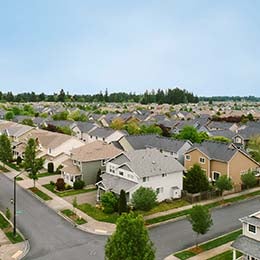
US and global commercial real estate — fourth quarter 2025 outlook
In today’s environment, we believe properties with income growth that’s less tied to the business cycle are best positioned to outperform.
Many investors are familiar with the appeal of holding real estate. With a generally low correlation to other asset classes1, real estate can serve as an instant diversifier in a mixed-asset portfolio.
Historically, real estate has delivered strong relative performance across multiple cycles compared to other asset classes. Its characteristic stable income, underpinned by long-term leases, makes real estate a compelling alternative.
At its core, real estate is a local asset class. Moving beyond one’s domestic market, however, can offer significant diversification benefits and produce a smoothing effect on returns.
Navigating the risks and opportunities of a diverse and nuanced asset class requires deep and varied experience. Invesco has a 39-year track record of building global real estate investment programs and funds for many of the world’s leading institutional investors.
Designed to bring together both private and public real estate, GPP offers accredited investors access to global direct real estate with daily liquidity, along with stable income with lower volatility.
Provides exposure to high-quality real estate companies, including those that own higher-quality properties in markets with growth prospects and that feature attractive management, governance, and balance sheet characteristics

US and global commercial real estate — fourth quarter 2025 outlook
In today’s environment, we believe properties with income growth that’s less tied to the business cycle are best positioned to outperform.

What are global investor flows into US real estate?
Reduced cross-border investment in new US commercial real estate may impact US and global property sectors, markets, and assets differently.

What will happen to commercial real estate values in 2025?
An important leading indicator for commercial real estate is suggesting a high probability for property value growth in 2025, even amid tariff policy volatility.

Private real estate and the impact of tariffs: Stay measured
Sharp shifts in US tariff policies have disrupted markets. Here’s insight on what it might mean for private real estate investments.

Single-family rentals: What real estate investors need to know
As a large and integral part of the U.S. rental housing market, the single-family rental sector is a key investment area. Get insight on the trends, fundamentals, and investment opportunity.

Learn how alternative investments can help align portfolios with investment objectives as long-term return expectations across traditional markets decline.

Client-focused fixed income solutions that help you navigate the always changing world of bond investing.

Learn about Invesco's lineup of ETFs, including what they are, how they compare to mutual funds, and what types are available.
NA 4445616
This link takes you to a site not affiliated with Invesco. The site is for informational purposes only. Invesco does not guarantee nor take any responsibility for any of the content.